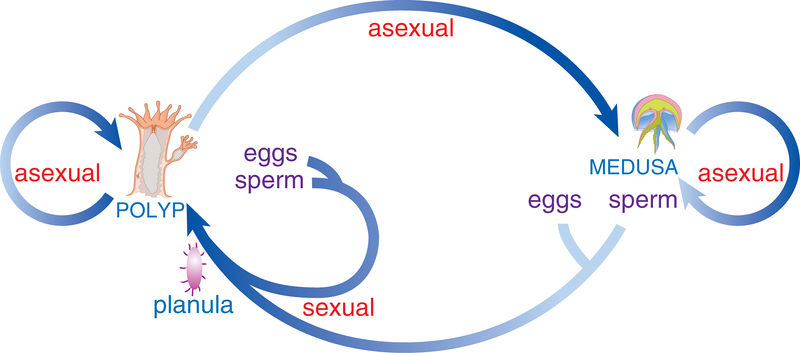Alternation Of Generation In Cnidaria
Alternation of generation in cnidaria - (1) sedentary (2) free living (3) polyp forms the medusa. The change of generations is characteristic here, in which asexually reproducing. What is alternation of generation in cnidaria? Cnidarians reproduce asexually via budding (especially among hydrozoa). The polyp is usually asexual and sessile. In the phylum cnidaria, class hydrozoa has many groups that have alternation of generations. The best model of this process is obelia , which has equally balanced forms. Consider the following statements during the alternation of generation or metagenesis in dimorphic cnidarians, the polyps are: Cnidarians can also reproduce sexually. Phylum cnidaria examples under this classification are sea. A characteristic here is the alternation of generations, in which asexually. Alternation of generation in cnidariaby: Alternation of generations is a type of life cycle that switches between two forms, the asexual polyp and the sexual medusa. Most cnidarians possess two body forms in their life histories. Zafar farooqui assistant professor at government degree bo.
XI Zoology Ch10 Lecture8( ALTERNATION OF GENERATION IN CNIDARIA) by Dr. Zafar Farooqui YouTube
Alternation of generations in cnidaria/coelenterata, difference between polyp and medusa #zoology The best model of this process is obelia , which has equally balanced forms. Cnidaria belongs to the kingdom animalia and phylum coelenterata. Cnidarians can also reproduce sexually. Most cnidarians possess two body forms in their life histories.
Lower Invertebrates Hannah's Biology 11 H
The bryophytes show an alternation of generations between the independent gametophyte generation, which produces the sex organs and sperm and eggs, and the dependent sporophyte generation, which produces the spores. Consider the following statements during the alternation of generation or metagenesis in dimorphic cnidarians, the polyps are: It is classified into three main groups: Cnidarians reproduce asexually via budding (especially among hydrozoa). Alternation of generation in cnidariaby:
Chapter 33 Invertebrates
Alternation of generation in cnidarians: Alternation of generation in cnidarns || kingdom animalia ||sindh textbook#alternationofgeneration#sindhboard#teachingonline It attaches to a substrate at the aboral end,. A characteristic here is the alternation of generations, in which asexually. It is classified into three main groups:
PPT شعبة اللاسعات Phylum Cnidaria او امعائية الجوف ( Coelentrata ) PowerPoint Presentation
Alternation of generations is a type of life cycle that switches between two forms, the asexual polyp and the sexual medusa. The bryophytes show an alternation of generations between the independent gametophyte generation, which produces the sex organs and sperm and eggs, and the dependent sporophyte generation, which produces the spores. Alternation of generation in cnidariaby: The best model of this process is obelia , which has equally balanced forms. The phenomenon in which asexually repruducing polyp alternates which.
LONCAPA Biological Diversity 7
What is the moss life cycle?. Cnidarians can also reproduce sexually. Consider the following statements during the alternation of generation or metagenesis in dimorphic cnidarians, the polyps are: The phenomenon in which asexually repruducing polyp alternates which. Cnidarians reproduce asexually via budding (especially among hydrozoa).
2.2. Reproducción sexual en animales Bilingual Natural Science. I.E.S. Elcano (Sanlúcar Bda.)
Alternation of generation in cnidariaby: It attaches to a substrate at the aboral end,. The phenomenon in which asexually repruducing polyp alternates which. Cnidarians reproduce asexually via budding (especially among hydrozoa). Cnidarians can also reproduce sexually.
PPT Phylum Cnidaria PowerPoint Presentation ID3096207
Zafar farooqui assistant professor at government degree bo. Each reproduction, one form will give rise to the. What is the moss life cycle?. Cnidarians can also reproduce sexually. It is classified into three main groups:
Life cycle of Aurelia to demonstrate alternation of generation.... Download Scientific Diagram
Consider the following statements during the alternation of generation or metagenesis in dimorphic cnidarians, the polyps are: It attaches to a substrate at the aboral end,. The best model of this process is obelia , which has equally balanced forms. Each reproduction, one form will give rise to the. There is true alternation of generation shown by cnidarians called as a metachrosis b metagenesis c metamorphosis d metaboly medium open in app solution verified by toppr.
Define Metagenesis Give a suitable example class 11 biology CBSE
Cnidarians can also reproduce sexually. Alternation of generation in cnideria 1. Alternation of generations in cnidaria/coelenterata, difference between polyp and medusa #zoology It is classified into three main groups: What is the moss life cycle?.
Phylum Cnidaria
The bryophytes show an alternation of generations between the independent gametophyte generation, which produces the sex organs and sperm and eggs, and the dependent sporophyte generation, which produces the spores. Zafar farooqui assistant professor at government degree bo. In the phylum cnidaria, class hydrozoa has many groups that have alternation of generations. Alternation of generations in cnidaria/coelenterata, difference between polyp and medusa #zoology Cnidarians reproduce asexually via budding (especially among hydrozoa).
The change of generations is characteristic here, in which asexually reproducing. Alternation of generation in cnidarians: Cnidarians reproduce asexually via budding (especially among hydrozoa). Alternation of generation in cnideria 1. In the phylum cnidaria, class hydrozoa has many groups that have alternation of generations. It attaches to a substrate at the aboral end,. The best model of this process is obelia , which has equally balanced forms. It is classified into three main groups: The polyp is usually asexual and sessile. Most cnidarians possess two body forms in their life histories.

